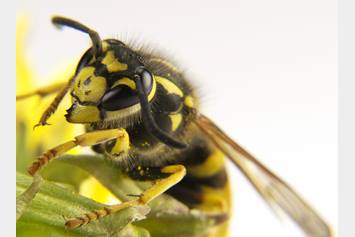Allergy to Stinging Insects
Children who are allergic to the venom (poison) in bees and other insects should take steps to avoid being stung. Bee stings can cause severe allergic reaction.
Allergic Reaction to Stinging Insects
Bee stings can hurt, but can also cause severe allergic reactions in a few people. Children who are allergic to the venom (poison) in bees and other insects should take steps to avoid being stung. When outside:
- Wear light, pale colors instead of bright or very dark colors. Avoid clothing with colorful or flowery patterns.
- Choose unscented deodorants, hair products, and lotions (including suntan lotion) when possible. Avoid perfumes.
- Avoid drinking or eating sweet things, like soda pop or popsicles. Look before sipping, especially from pop cans. Try not to eat outside.
- Stay away from uncovered food and open garbage cans.
- Be aware that bees often gather near flowering plants, fruit trees or vines with ripe fruit, stacks of firewood, or hollowed out logs
Types of Reactions
Local and Allergic Systemic (Anaphylactic Shock)
A local reaction to bee stings is not life-threatening. When a child is stung many times, the reaction may still be local. Multiple stings do not mean that the child will become allergic to bees.
At the sting site, there may be:
- Redness, swelling, a welt
- Sharp, burning pain
- Itching
An allergic systemic reaction, also called anaphylaxis or anaphylactic shock, is the most severe type of reaction and can be life threatening. The symptoms of a systemic reaction usually develop within 30 to 60 minutes.
The most common symptoms of an anaphylactic shock reaction are:
- Throat: throat tightens, is hoarse or scratchy
- Breathing: wheezing, repeated cough or shortness of breath
- Heart: lightheaded feeling, fainting, weak pulse, low blood pressure
- Mouth: swollen tongue, slurred speech or blueness around the lips, drooling
- Skin: severe swelling or severe itching of face, scalp, arms or legs or the appearance of large hives covering the body
- Stomach: vomiting two or more times or severe stomach cramps
- Feeling of doom
How Are Stings Treated?
Treating a Local Reaction
- If you can see the stinger (tiny black object) in the skin, scrape it off. Do not pinch the stinger with fingers or tweezers because this will squeeze more venom into the skin. Instead, run a credit card across the stinger, from the opposite direction that it went in. For honeybee stings, part of the bee’s body may be attached to the stinger. Wasps, yellow jackets, and hornets do not leave a stinger and can sting many times.
- If possible, wash the area with soap and water.
- Put cold compresses (ice pack or cold wet washcloths or towels) on the sting site.
- If stung on a finger, arm, foot, or leg, raise the sting site above the level of the heart to reduce swelling.
- Give an over-the-counter (OTC) antihistamine medicine that has diphenhydramine, such as Benadryl®. Read the label to know the right dose for your child.
- To relieve itching, put calamine lotion on the sting site. Sometimes taking a cool bath or adding 2 cups of ground oatmeal or Aveeno® to the bath water can help.
Treating a Systemic Reaction (Anaphylaxis)
Doctors often prescribe an epinephrine auto-injector device (Adrenaclick® Auvi-Q® and EpiPen®) for people with an allergy to bee stings. The auto-injector contains a pre-measured dose of medicine that can stop the systemic reaction. Your child’s doctor will prescribe the right dose for your child based on his or her weight.
Call 9-1-1 after using an epinephrine auto-injector.
If you do not have an epinephrine auto-injector and your child is having symptoms of anaphylactic shock, call 9-1-1 and get emergency help right away.
Safety Tips
- If a stinging insect flies near or lands on your child, teach him to stay calm and slowly walk away. Fast movements or swatting may cause the insect to sting.
- Your child should always wear closed-toed shoes, long sleeves and long pants when outdoors. Do not let him walk barefoot. He should avoid wearing loose fitting clothing that can trap the insect inside.
- Always have an extra epinephrine auto-injector available. Do not store the injector in a refrigerator or a hot car.
- If your child has had a systemic reaction to a stinging insect, he should wear a medical ID bracelet or necklace (available at most pharmacies and online).
When to Call Your Doctor
Allergy Testing
If you think that your child may be allergic to a stinging insect, contact your child’s doctor to discuss allergy testing. Any child who has had a systemic reaction should be tested. Allergy shots can often prevent future systemic reactions. Your allergy specialist will decide if your child needs these shots.
Helping Hands Patient Education Materials
Written and illustrated by medical, nursing and allied health professionals at Nationwide Children's Hospital, Helping Hand instructions are intended as a supplement to verbal instructions provided by a medical professional. The information is periodically reviewed and revised to reflect our current practice. However, Nationwide Children's Hospital is not responsible for any consequences resulting from the use or misuse of the information in the Helping Hands.
HH-I-74 | ©1978, revised 12/18, Nationwide Children’s Hospital



